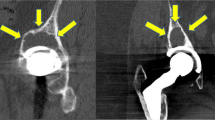Abstract
Introduction
Biodegradable polylevolactic acid implants have become more commonly used for the treatment of fractures and osteotomies over the past few years. In the present study, the biocompatibility and degradation of polylevolactide screws used for rotational acetabular osteotomy were assessed on the basis of radiographic and MRI findings.
Materials and methods
Forty-nine hips of 47 patients were analyzed for this study. The average age of the patients at the time of surgery was 38.0 years (range 18–62 years). The original diagnosis was osteoarthritis in 43 hips and osteonecrosis in 6 hips. The mean duration of follow-up was 2.8 years (range 1.5–5.5 years). Anteroposterior radiographs obtained at 1 week, 6 months, 1 year after the operation, as well as the most recent radiographs, were used to assess bony union, the radiolucent tract of each screw, and the sclerotic rim around each screw. Fifteen patients were chosen randomly to undergo MRI.
Results
Union of the osteotomized surfaces occurred in all patients within 6 months of surgery. Radiographs showed no osteolysis, no formation of bone cysts, and no displacement of the osteotomized acetabulum in any of the 49 hips. None of the patients was found to have any complications caused by problems with the biocompatibility of the implants. At the final postoperative examination, a central radiolucent tract and a sclerotic rim around the screws were seen in 34/49 hips (69%) and 23/49 hips (47%), respectively. On MRI findings, we were able to detect significant resorption of the screws in two patients after 1.2 and 1.7 years of follow-up. Though localized low-intensity areas on T1-weighted images and high-intensity areas on T2-weighted images were observed at the top of the screws in 5 patients, there was no development of pain, tenderness, or a sinus during the follow-up period.
Conclusion
Although absorption of polylevolactic acid screws did not occur in a large majority of cases, rotational acetabular osteotomy appears to be a good indication for the use of polylevolactic acid screws.




Similar content being viewed by others
References
Bergsma JE, Bruijn WC de, Rozema FR, Bos RR, Boering G (1995) Late degradation tissue response to poly (L-lactide) bone plates and screws. Biomaterials 16:25–31
Bostman OM, Pihlajamaki HK (2000) Adverse tissue reactions to bioabsorbable fixation devices. Clin Othop 371:216–227
Bostman OM, Pihlajamki HK (1998) Late foreign-body reaction to an intraosseous bioabsorbable polylactic acid screw. J Bone Joint Surg Am 80:1791–1794
Bostman OM, Pihlajamaki HK, Partio EK, Rokkanen PU (1995) Clinical biocompatibility and degradation of polylevolactide screws in the ankle. Clin Orthop 320:101–109
Casteleyn PP, Handelbelg F, Hantjens P (1992) Biodegradable rods versus Kirschner wire fixation of wrist fractures, a randomized trial. J Bone Joint Surg Br 74:858–861
Hoffmann R, Krettek C, Hetkamper A, Haas N, Tscherne H (1992) Osteo-synsthese distaler Radiusfrakturen mit biodegradablen Fraktur-stiften. Zweijahresergebnisse. Unfallchirurg 95:99–105
Hovis WD, Bucholz RW (1997) Polyglycolide bioabsorbable screws in the treatment of ankle fractures. Foot Ankle Int 18:128–131
Ito H, Minami A, Tanino H, Matsuno T (2002) Fixation with poly-L-lactic acid screws in hip osteotomy: 68 hips followed for 18–46 months. Acta Orthop Scand 73:60–64
Lajtai G, Schmiedhuber G, Unger F, Aitzetmller G, Klein M, Noszian I, Orthner E (2001) Bone tunnel remodeling at the site of biodegradable interference screws used for anterior cruciate ligament reconstruction: 5-year follow-up. Arthroscopy 17:597–602
Martineck V, Friedrich NF (1999) Tibial and pretibial cyst formation after anterior cruciate ligament reconstruction with bioabsorbable interference screw fixation. Arthroscopy 15:317–320
Matsusue Y, Hanafusa S, Yamamuro T, Shikinami Y, Ikada Y (1995) Tissue reaction of bioabsorbable ultra high strength poly (L-lactide) rod. A long-term study in rabbits. Clin Orthop 317:246–253
Nakamura S, Takatori Y, Morimoto S, et al (1999) Rotational acetabular osteotomy using biodegradable internal fixation. Int Orthop 23:148–149
Ninomiya S, Tagawa H (1984) Rotational acetabular osteotomy for the dysplastic hip. J Bone Joint Surg Am 66:430–436
Nozawa M, Shitoto K, Matsuda K, Maezawa K, Kurosawa H (2002) Rotational acetabular osteotomy for acetabular dysplasia. J Bone Joint Surg Br 84:59–65
Rokkanen PU (1991) Absorbable materials in orthopaedic surgery. Ann Med 23:109–115
Simon JA, Ricci JL, Di Cesare PE (1997) Bioresorbable fracture fixation in orthopedics: a comprehensive review. Part II. Clinical studies. Am J Orthop 26:754–762
Takizawa T, Akizuki S, Horiuchi H, Yasukawa Y (1998) Foreign body gonitis caused by a broken poly-L-lactic acid screw. Arthroscopy 14:329–330
Warden WH, Friedman R, Teresi LM, Jackson DW (1999) Magnetic resonance imaging of bioabsorbable polylactic acid interference screws during the first 2 years after anterior cruciate ligament reconstruction. Arthroscopy 15:474–480
Yoshino N, Takai S, Watanabe Y, Kamata K, Hirasawa Y (1998) Delayed aseptic swelling after fixation of talar neck fracture with a biodegradable poly-L-lactide rod: case reports. Foot Ankle Int 19:634–637
Author information
Authors and Affiliations
Corresponding author
Rights and permissions
About this article
Cite this article
Maezawa, K., Nozawa, M., Matsuda, K. et al. Radiographic and magnetic resonance imaging findings of polylevolactic acid screws after rotational acetabular osteotomy. Arch Orthop Trauma Surg 124, 455–460 (2004). https://doi.org/10.1007/s00402-004-0703-4
Received:
Published:
Issue Date:
DOI: https://doi.org/10.1007/s00402-004-0703-4




